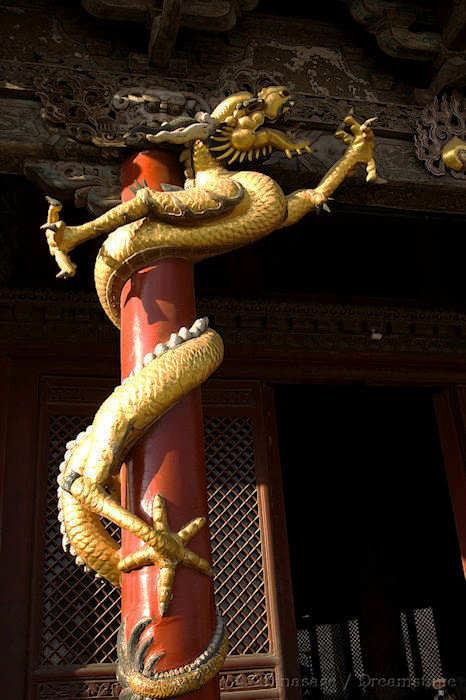
Dragons, Qilin, Phoenix and other Mythical beasts
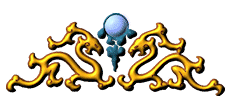
Chinese Dragons
Dragons in China are not the fire-breathing, evil monsters that they are portrayed elsewhere in the world. Maybe a different word should have been used to distinguish the Chinese version of these mythological creatures. The Chinese dragon is imperious, powerful but good-natured. People need to seek the favor of dragons and keep them on their side. It is a strong ‘yang’ animal (male, sun and active); as such it associated with the number nine (as 3 is yang, 3x3 is extremely yang) and so Nine Dragons 九龙 jiǔ lóng are extremely propitious. Kowloon, part of Hong Kong means ‘nine dragons’ in Cantonese. There is an impressive imperial Nine Dragon Wall of glazed tiles at both the Summer Palace and the Forbidden City at Beijing.
According to an ancient classification the dragon is considered the chief of all scaled creatures, while birds are represented by the phoenix; animals by the unicorn and all shelled creatures by the tortoise. It is second only to humans in the hierarchy of animals. It has a sinuous body covered in scales, with four legs and two horns. It is said to be a composite of nine different creatures: camel’s head, deer’s horns, rabbit’s eyes, cow’s ears, snake’s neck, frog’s belly, carp’s scales, hawk’s claws and tiger’s palm. There are traditionally 81 (9x9) scales running along its spine. Its face has whiskers and a beard.
Dragons were well established in the Chinese mind as far back as the Shang dynasty. Dragon shape decorations have been found on Yangzhou pottery dating back 6,000 years and there are hints that the original inspiration for a dragon was the alligator ➚ of Southern China. Dragons are lords of nature, commanding the mountains, sky, sea and land. Dragons belong to various categories: heaven dragons (天龙 tiān lóng) ruling the sky; spirit dragons (神龙 shén lóng) ruling the rain; earth dragons (地龙 dì lóng) ruling springs and streams, and treasure dragons (伏藏龙 fú cáng lóng) which guard buried riches. The blue-green dragon ( ) represents east and spring and is one of the four divisions of the traditional month. The river forming a long stretch of China's north-eastern border is the 黑龙江 hēi lóng jiāng ‘Black Dragon River’ which in turn gives its name to the whole province. Buddhists brought with them into China a rather different view of dragons more akin to the europeans, Buddhist dragons are more cantankerous and prone to malice.
The Blue Dragon festival takes place on the 2nd day of the 2nd lunar month each year. This was the day Lóng tái tóu 龙抬头 when the dragons by tradition stirred from their winter slumber.
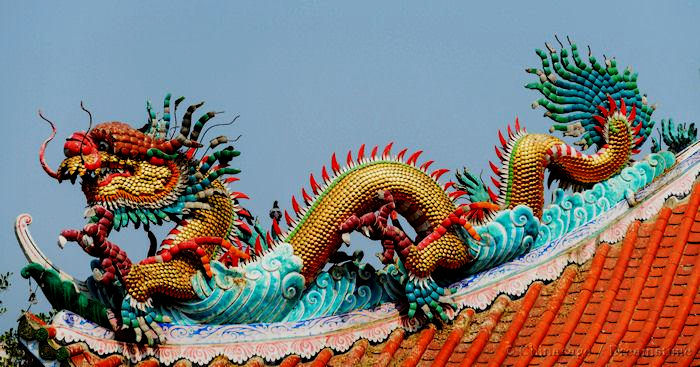
A representation of a 贪龙 Tān lóng ‘greedy dragon’ was often put at the entrance to the administrator's house (the yamen) so that the administrator and all the supplicants were encouraged to keep themselves on good behavior by this savage and hungry representation of a dragon.
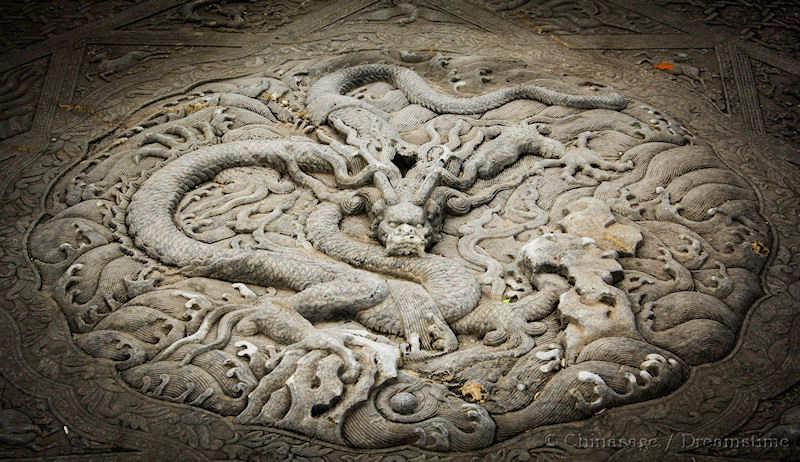
Hidden Dragons
Feng shui favors sites with a ‘hidden dragon’, which is found where the form of the surrounding hills look like a huge protecting dragon. Ideally this should be to the east of the location as in the case of the city of Nanjing. The film title Crouching tiger, Hidden dragon ➚ comes from a place of hidden strength, and a most auspicious Feng Shui location.
Chinese Dragons are mostly associated with water, with the power to bring drought or floods, and so they controlled the lives of all those who cultivate the fields. Legend has it that a son of the Emperor Hongwu chose the site for the city of Beijing as the Ming capital after he had managed to tame two dragons who controlled the city's water supply. The belief in dragons has remained strong, at the start of the 20th century 82% of people believed they existed and Yuan Shikai in 1912 sought to legitimize his claim to the Imperial throne by the appearance of a dragon - he sent teams of people to go and look for one.
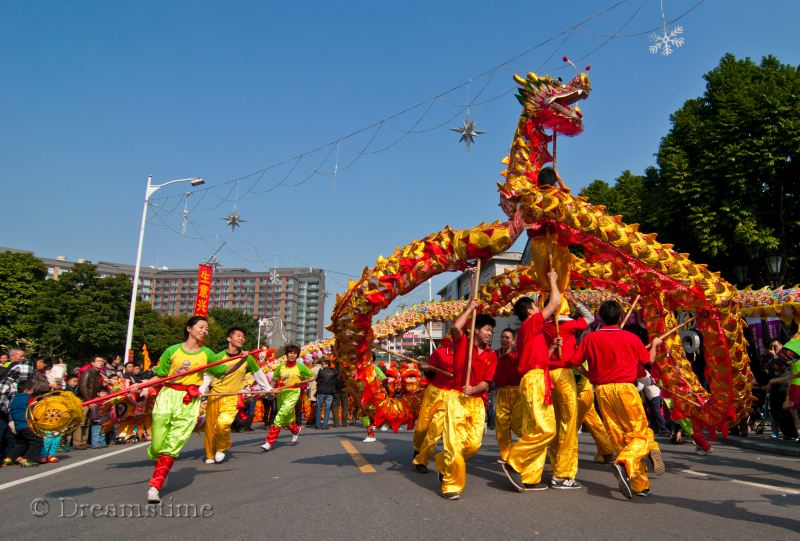
Dragon Kings
The seas are ruled by dragon kings (龙王 lóng wáng), one for each of the traditional four seas that surround China. If a dragon king takes to the air it brings a great storm and rain - a typhoon (台风 tái fēng in Chinese). The Dragon King, ruler of water, traditionally lies out in the sun to dry his scales on the sixth day of the sixth lunar month. Death by drowning was considered a sacrifice to the dragon king and this is tied to the origin of the Dragon Boat festival which at a later date came to commemorate the drowning of Qu Yuan. Originally people pleaded with the dragons to bring rain for a good harvest at this mid-summer festival as a drought was just as ruinous as a flood.

In ancient times lightning was considered to be ‘dragon fire’. An eclipse of the moon or sun was believed to be caused by a dragon eating the celestial body. The Moon was said to rise between the horns of the Spring Dragon. As the moon is often represented as a pearl, the common depiction of two dragons chasing and holding pearls (as in the Dragon Dance) relates to moon and thunder. Others say the pearl represents knowledge or the sun.
A lower category of dragon are the ‘Hornless dragons ➚’ 螭 chī also known as ‘mountain demons’. They are depicted as small dragons without horns: 螭吻 ‘Chī wěn’ considered by some to be the Chinese chimera ➚ and sometimes also termed 辟邪 bì xié. An early form of the dragon is the 夔 Kuí dragon that is shown more like a snake with one leg or no legs typically decorating Shang dynasty bronzes. The kui is considered an emblem to remind people to refrain from greed.
There are many assorted dragon connections. Fossils of animals were known as ‘dragon's bones and teeth’. Traditional medicines are often named after parts of the dragon to advertise their potency. The Dragon Dance takes place at Chinese New Year and also at marriage ceremonies. Carvings of dragons and chiwen are some of the mythological beasts placed at the ends of the roof ridges of buildings. On the very top of the roof ridge they acted as lightning conductors.
Proverbial Dragons
Dragons are one of the twelve animals of the astrological year, people born in a dragon year are born leaders and very lucky as a dragon year is considered the best astrological year. For more on dragon symbolism please refer to our symbolism section.
The Dragon Throne
The dragon has been the symbol of the emperor since the Han dynasty. The emperor ruled China from the Dragon Throne ➚ at the Imperial capital (Beijing, Nanjing and other cities over the centuries). The dragon throne faced south and was considered the very center of the civilized world. The number of claws of the dragon's feet became important, but only later on. They are often portrayed on ceramics, silk and carvings. The five clawed dragon is reserved for the emperor and his sons; anyone else found with a depiction of a five clawed dragon could be executed. Princes of the third and fourth rank were allowed four clawed dragons, three claws or less were reserved for the top officials at court.
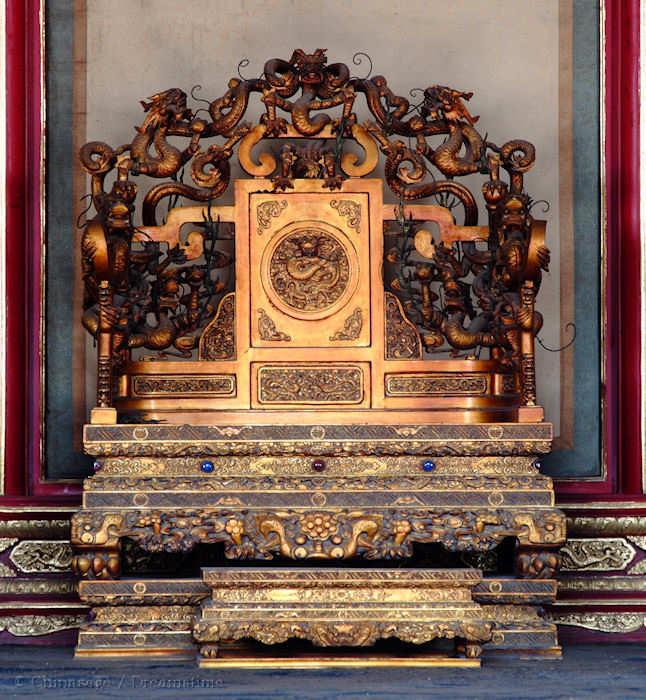
A very influential portrayal of dragons was made by the artist Chen Rong in 1244. From then on most dragons conform to this style.
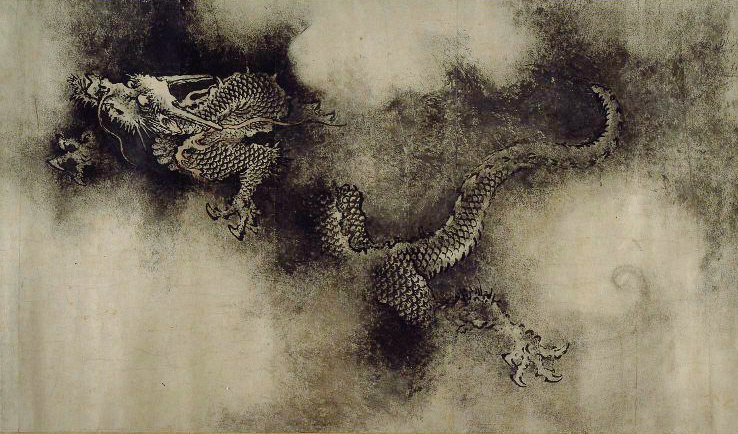
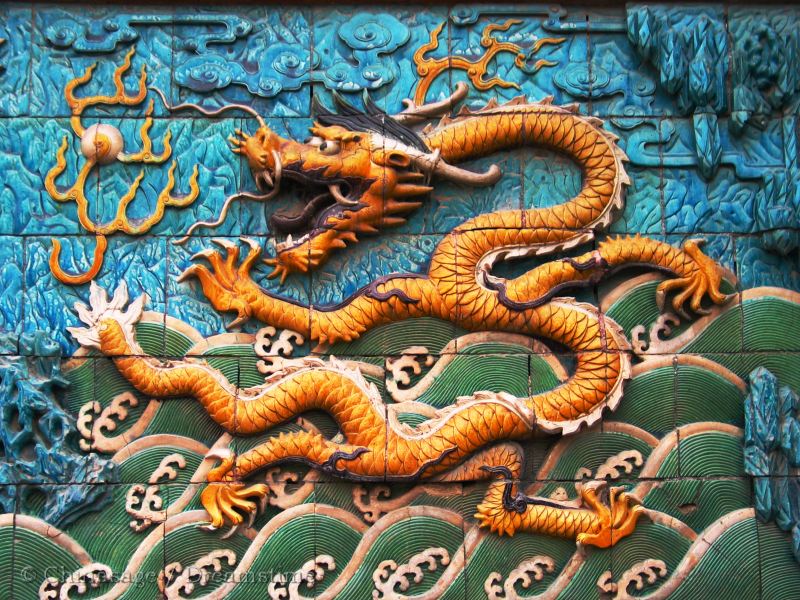
Qilin
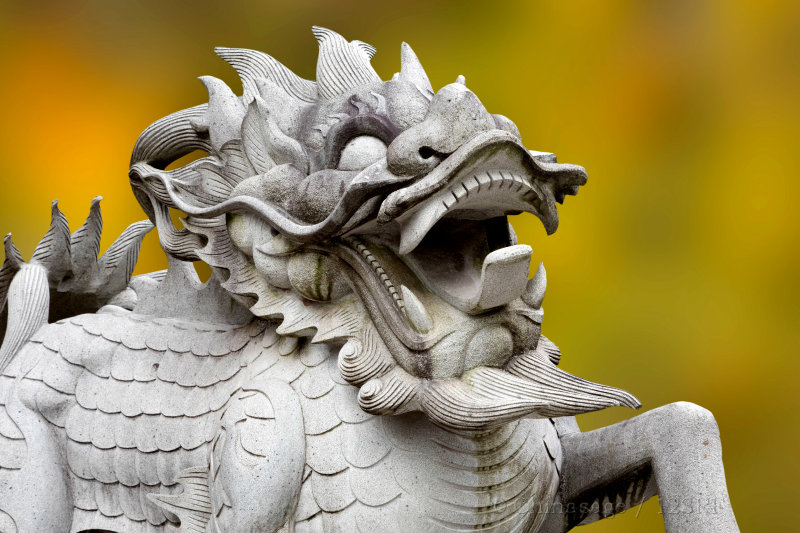
The Qilin is a mythical creature just like the Dragon and Phoenix. The Chinese name 骐麟 Qílín is sometimes written as ‘kilin’ or ‘kylin’. The character ‘Qi’ is a kind of horse and so has the horse radical while the ‘Lin’ character is a complex character made up of 23 individual strokes representing a female unicorn.
A stone qilin often guards a tomb, sometimes as one of the creatures along a Sacred Way. The best known example is on the Spirit Way to the Ming tombs in Beijing.
Although described as the ‘Chinese Unicorn’ the creature is somewhat different to the western unicorn, it normally has two horns but may have one or three and a deer's body but often the sculptor has gone to town with their imagination and embellished with fish scales and an ox's tail. It is usually is given a white color. A qilin is the representative of all animals bearing fur (horses; cows; goats; deer and so on) and is one of the four sacred animals with the dragon, turtle and phoenix. When Zheng He's voyages to Africa brought back a giraffe as a gift to Emperor Yongle, it was thought that it must be some sort of Qilin, the Emperor did not agree but in Japan ➚ the giraffe is retains the name qilin to this day.
The similarity to the western unicorn is mainly due to its association with gentleness, virtue and benevolence. One tradition has a qilin bringing a piece a jade to the mother of Confucius to herald his auspicious birth. Its walk is so gentle that its hooves do not crush the grass and it can walk on water. Evil spirits melt away in its presence. The appearance of a qilin is considered a very auspicious omen and so it is said to have appeared during the reign of the Yellow Emperor (Huangdi). They are solitary animals. It became associated with a talented young son. The Qilin is often used as a symbol in paintings and ceramics with the hidden meaning of a wish that a husband will produce sons.
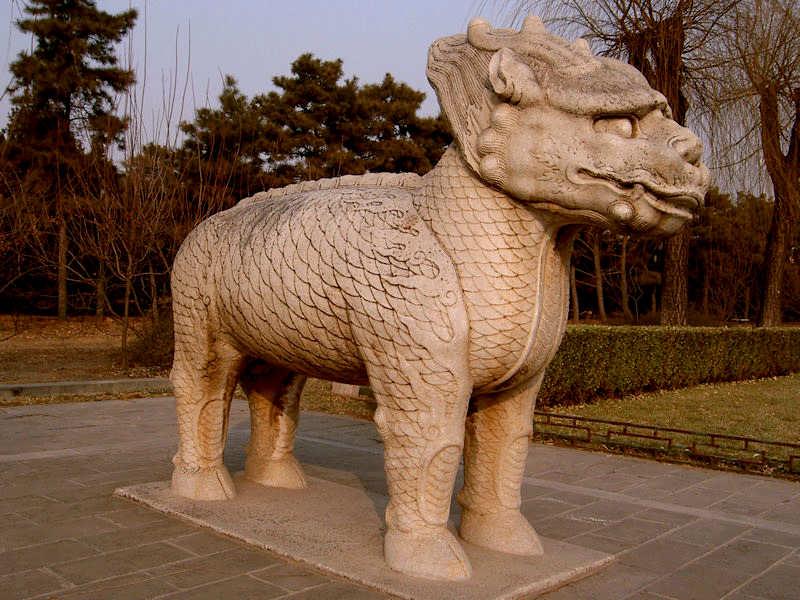
Phoenix - Fenghuang
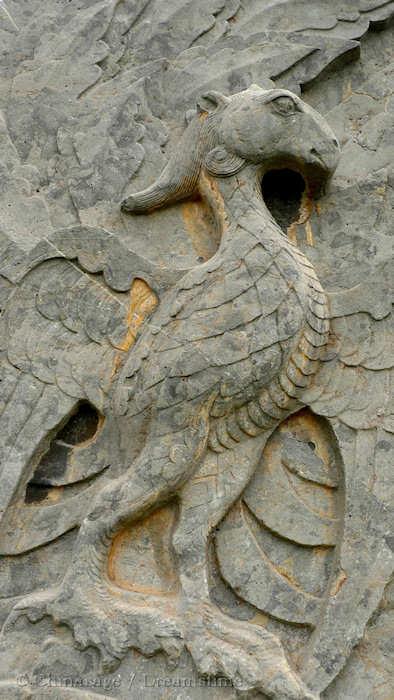
As with the dragon the Chinese phoenix has little in common with the mythical bird of Egyptian origin ➚. The Europeans chose to give the Chinese phoenix, Feng huang 凤凰 the same name as a vaguely similar bird but it does not have the legend of fiery rebirth and immortality associated with the western phoenix. The history of the ancient Chinese mythological creature goes back at least 4,000 years. Like the Qilin it is considered a creature whose appearance signifies the just rule of the Emperor. The Chinese name is made up of fèng (wind) and huáng (a homophone with emperor showing the emperor under a canopy). The phoenix appears at auspicious times, and is associated with sun, south, justice, obedience and loyalty. It is a peaceful creature accompanied by small birds. It perches on the admired 梧桐 wútóng ‘Chinese Parasol’ tree (Firmiana simplex).
The phoenix represents the class of all birds. Early (Zhou and Shang) representations make it more like a bird of prey with a curved beak; in later centuries it became to look like a pheasant which is native to China.
Landmarks named after the phoenix include the mountain ‘Fenghuang Shan’ near Dandong, Liaoning with many Daoist temples dotted over it. Fenghuangfu in Anhui is credited with its last sighting, where it scratched at the grave of Ming Emperor Hongwu's father, giving him legitimacy to rule.
In later centuries the Empress became associated with the phoenix. As the dragon represents the Emperor, the dragon and phoenix together stand for Emperor and Empress. A picture with a dragon and phoenix together symbolizes a married couple and based on this there has been a long association of the phoenix with marital sex. Famously the Qing dynastic tomb near Beijing of the Dowager Empress Cixi has the phoenix dominating the dragon, signifying her pre-eminence at the Imperial court.
Proverbial Phoenixes
Other mythical creatures
Apart from the dragon, phoenix and qilin there are quite a few other mythical beasts that can be seen as ornaments, motifs and statues. The names are often confused as the sculptures varied in form over the centuries.
Bixi 赑屃 bì xìPi-hsi WG
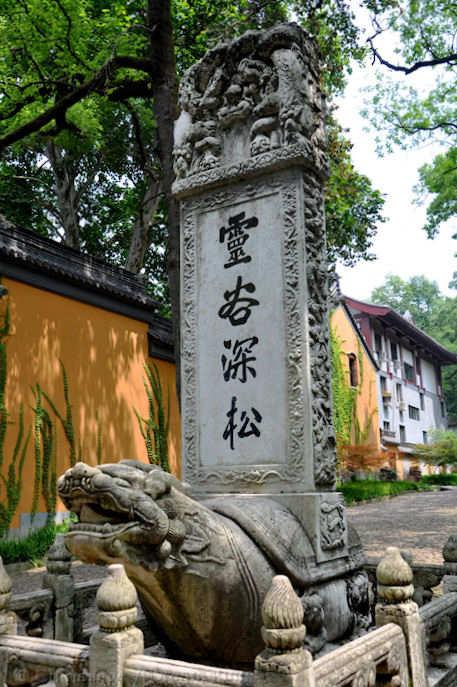
This a mix of a dragon and the turtle as it has a dragon-like body within a turtle-like shell. A bixi is most commonly seen as the decorative base of a commemorative tablet to the dead. They are also seen at the bases of bridges and archways. A creation legend has the bixi of one of nine disparate sons of the dragon (龙生九子 Lóng shēng jiǔ zǐ).
Sculptures of the bixi began to be made by the late Han dynasty and continued to the last Qing dynasty. The early forms were more like turtles and over time became more like dragons.
Pixiu 貔貅 pí xiūP'i-hsui WG
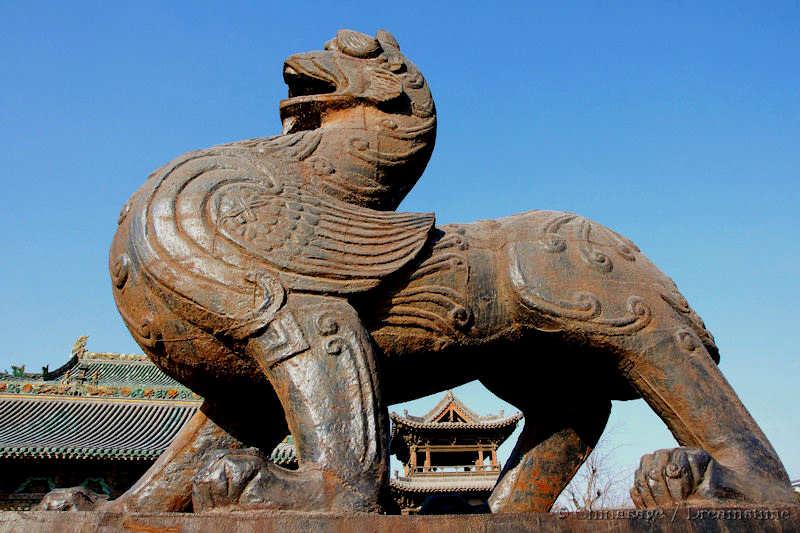
A pixiu is a mix of dragon and lion features so could be classed as a chimaera - a sort of flying lion. The female form usually has two horns/antlers while the male form (天禄 tiān lù) has only one. It is considered a talisman that will bring wealth and so is often seen with jade, silver and gold. The creature is sometimes included as one of the defenders of grand buildings and as a tomb guardian.
Xiezhi 獬豸 xiè zhì
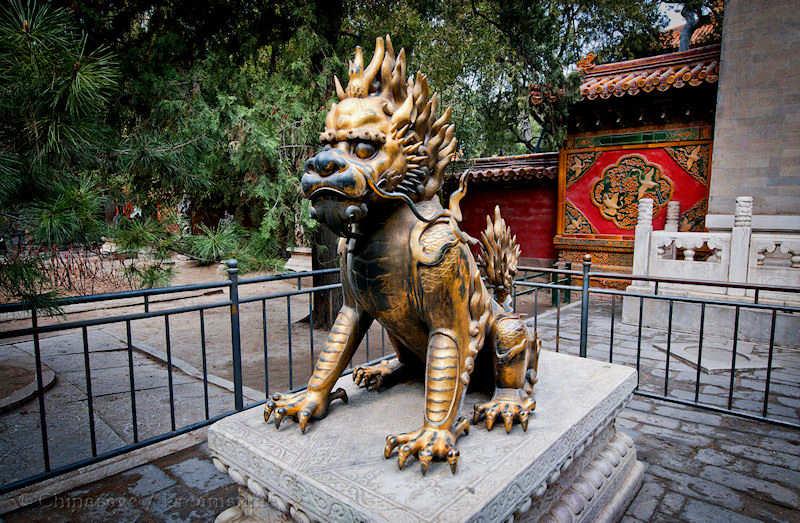
The creature is endowed with the ability to separate the guilty from the innocent. A xiezhi is usually portrayed as a one-horned ferocious creature. With its association with justice, statues are often to be seen outside criminal courts. The most well-known example guards the Forbidden City in Beijing. It is however often confused with a qilin.